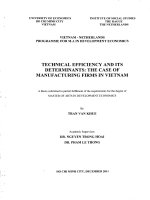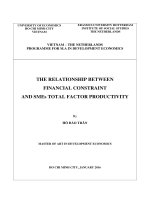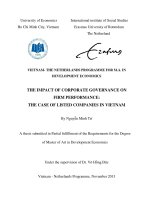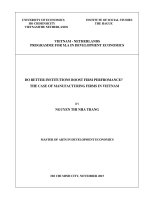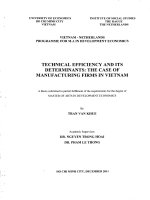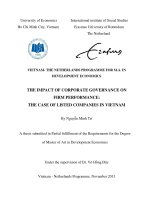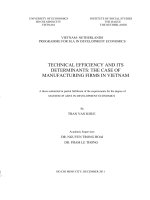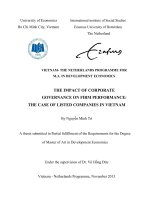Knowledge spillover, sectoral innovation and firm total factor productivity the case of manufacturing industries in vietnam
Bạn đang xem bản rút gọn của tài liệu. Xem và tải ngay bản đầy đủ của tài liệu tại đây (2.22 MB, 209 trang )
MINISTRY OF EDUCATION AND TRAINING
UNIVERSITY OF ECONOMICS HO CHI MINH CITY
*****
NGUYEN THI HOANG OANH
KNOWLEDGE SPILLOVER, SECTORAL INNOVATION AND FIRM
TOTAL FACTOR PRODUCTIVITY:
THE CASE OF MANUFACTURING INDUSTRIES
IN VIETNAM
PhD THESIS
HO CHI MINH CITY, 2021
NGUYEN THI HOANG OANH
KNOWLEDGE SPILLOVER, SECTORAL INNOVATION AND FIRM
TOTAL FACTOR PRODUCTIVITY:
THE CASE OF MANUFACTURING INDUSTRIES
IN VIETNAM
Major: Development Economics
Code: 9310105
PhD Thesis
ACADEMIC ADVISORS
1. Dr. Pham Khanh Nam
2. Dr. Pham Hoang Van
HO CHI MINH CITY, 2021
iii
COMMITMENTS
I hereby declare that this dissertation is my own work and it has not been
previously submitted for a degree elsewhere. All the references from works done
by other authors have been explicitly cited. To the best of my knowledge, I would
like to certify that the above statements are true.
Ho Chi Minh City, January 2021
Nguyen Thi Hoang Oanh
ACKNOWLEDGEMENT
First of all, I would like to express my deepest gratitude to my academic advisers
Dr. Pham Khanh Nam and Dr. Pham Hoang Van for their valuable advices and
continuous support during my study. They have given me autonomy on doing my
research while continuing to provide me valuable feedbacks and encouragement.
Second, I would like to thank the School of Economics and University of
Economics Ho Chi Minh City for providing me the best environment for my study
and doing my research. I also would like to thank the board of professors and
independent external reviewers on giving me a lot of useful comments on my
research. All their comments enable me to improve and complete this version of my
thesis.
Last but not least, I am extremely grateful to my family for their love, support and
sacrifice. Without them, the completion of my dissertation would not have been
possible.
Ho Chi Minh City, January 2021
Nguyen Thi Hoang Oanh
Table of Contents
COMMITMENTS...................................................................................................................................i
ACKNOWLEDGEMENT........................................................................................................................ii
ABBREVIATIONS................................................................................................................................vii
LIST OF TABLES.................................................................................................................................viii
LIST OF FIGURES.................................................................................................................................x
Abstract.............................................................................................................................................. 1
Tóm tắt................................................................................................................................................2
CHAPTER 1. INTRODUCTION.............................................................................................................. 3
1.1.
PROBLEM STATEMENT............................................................................................................3
1.1.1.
The significance of the research’s topic.........................................................................3
1.1.1.1.
The importance of the research the role of knowledge spillovers on innovation
at sector level 3
1.1.1.2.
The importance of the research on heterogeneity of firms’ TFP in considering
both firms’ characteristics and spillover effects from sectors and regions...........5
1.1.1.3.
The importance of research on the role of knowledge spillovers on sectoral
innovation and firms’ TFP in the manufacturing industries in Vietnam...............7
1.1.2.
The gaps and the new aspects in this thesis..................................................................8
1.1.2.1.
The new aspects in theoretical framework............................................................8
1.1.2.2.
The new aspects of the methodology..................................................................10
1.1.2.3.
The new aspects of the context...........................................................................11
1.2.
RESEARCH OBJECTIVES AND QUESTIONS.............................................................................11
1.3.
RESEARCH METHODOLOGY and RESEARCH SCOPE.............................................................12
1.4.
RESEARCH CONTRIBUTION...................................................................................................13
1.5.
STRUCTURE OF THIS STUDY.................................................................................................14
CHAPTER 2. LITERATURE REVIEW....................................................................................................15
2.1.
DEFINITION AND CONCEPTS................................................................................................15
2.1.1.
Knowledge spillovers....................................................................................................15
2.1.2.
Innovation.....................................................................................................................17
2.1.3.
Knowledge production function and the determination of innovation in this study. 19
2.1.4.
Sectoral Innovation System (SIS) and its determinants...............................................21
2.1.5.
Total Factor Productivity (TFP).....................................................................................25
2.1.5.1.
Definition of Total Factor Productivity.................................................................25
2.1.5.2.
TFP measurement and its issue............................................................................27
2.1.5.3.
2.2.
TFP measurement methods..................................................................................28
THEORETICAL FRAMEWORK.................................................................................................29
2.2.1.
Developing model on Knowledge Spillovers at sector-level........................................29
2.2 2.
Channels of knowledge spillovers and the research hypothesis of the first objective 33
2.2.3.
Theoretical framework of knowledge spillovers to firms............................................37
2.2.3.1.
Debates on knowledge spillover of intra- sector to firms....................................37
2.2.3.2.
Human capital externalities from the province to firms......................................39
2.2.4.
2.3.
Multilevel modeling on firms’ total factor productivity and the research hypothesis of
the second objective....................................................................................................41
EMPIRICAL STUDIES..............................................................................................................45
2.3.1.
Empirical Studies on determinants of sectoral innovation..........................................45
2.3.2.
Empirical Studies on channels of knowledge spillover and applications of Spatial
Regression Model.........................................................................................................49
2.3.3.
Empirical Studies on TFP..............................................................................................54
CHAPTER 3. RESEARCH METHODOLOGY..........................................................................................62
3.1.
THE RESEARCH MODEL ON SECTORAL INNOVATION...........................................................62
3.1.1.
3.1.1.1.
The spatial econometrics and test for model specification.................................62
3.1.1.2.
Estimation Strategy of the Model........................................................................63
3.1.1.3.
Measuring Direct and Indirect effects in the Model............................................65
3.1.1.4.
Measurement variables........................................................................................67
3.1.1.5.
Hypothesis testing................................................................................................70
3.1.2.
3.2.
Model Specification......................................................................................................62
Data...............................................................................................................................71
The research model of Cross-Classified Model....................................................................72
3.2.1.
Measurement of Total Factor Productivity: Semi- parametric Approach...................72
3.2.2.
Data for measuring TFP................................................................................................74
3.2.3.
Application of Cross-Classified Multilevel Model on the study...................................76
3.2.4.
The Research Model of Cross-classified Model on Firm Productivity.........................78
CHAPTER 4. SECTORAL INNOVATION AND SPILLOVER EFFECTS: RESULTS FROM SPATIAL
REGRESSION MODELS AND DISCUSSIONS.......................................................................................84
4.1.
OVERVIEW OF RESEARCH AND DEVELOPMENT (R&D) ACTIVITIES AND PATENTS IN VIETNAM.....84
4.1.1.
R&D expenditure and R&D intensity in Vietnam.........................................................84
4.1.2.
Funding sources and performance of R&D activities..................................................86
4.1.3. The human resources in R&D activities............................................................................89
4.1.4.
The overview of the registration and approval of patents in Vietnam.......................93
4.1.5.
Overview of transfer channel of technology and innovation in Vietnamese
manufacturing industries.............................................................................................95
4.2.
DESCRIPTIVE STATISTICS.................................................................................................................100
4.3.
RESULTS OF THE MODEL ESTIMATION...........................................................................................104
4.4.
DISCUSSION ON THE RESULTS........................................................................................................111
CHAPTER 5. HETEROGENEITY IN TFP OF VIETNAMESE MANUFACTURING FIRMS: RESULTS FROM
CROSS-CLASSIFIED MODELS AND DISCUSSIONS............................................................................114
5.1.
THE MANUFACTURING INDUSTRIES AND FIRMS’ PRODUCTIVITY.....................................114
5.1.1.
The importance of manufacturing industries in Vietnam.........................................114
5.1.2.
The value added and contribution of capital, labor and TFP to economic growth by
economic activities in Vietnam..................................................................................120
5.1.3.
Overview of capital, labor and total factor productivity (TFP) in manufacturing
sectors in Vietnam......................................................................................................123
5.2.
Summary on characteristics of Vietnamese manufacturing enterprises in the research
data 126
5.3.
THE RESULTS OF MODEL ESTIMATION...............................................................................131
5.3.1.
The Cross classified model with no predictors (Empty Model).................................132
5.3.2.
The Fixed effect models.............................................................................................133
5.3.3.
The multilevel models: fixed region and random sector...........................................135
5.3.4.
The multilevel model: fixed sector and random province.........................................136
5.3.5.
The multilevel model with sector random effects and region random effects.........140
5.3.6.
The multilevel model with sector random effects and province random effects.....142
5.4.
SUMMARY ON RESULTS AND DISCUSSION........................................................................144
CHAPTER 6. CONCLUSION AND POLICY IMPLICATIONS.................................................................148
6.1.
CONCLUSIONS ON IMPORTANT FINDINGS.........................................................................148
6.2.
SOME POLICY IMPLICATIONS.............................................................................................149
6.3.
LIMITATIONS AND FUTHER RESEARCH...............................................................................151
REFERENCES........................................................................................................................................ i
APPENDIX..........................................................................................................................................xx
Table A1. Description of Sectors...................................................................................................xx
Table A2. The distribution of provinces by regions...................................................................xxiii
Table A3. Test on SDM versus SEM and SAR..............................................................................xxiv
B.
Spatial Regression Model in analysis on Knowledge Spillover among Sectors......................xxix
B1. General idea of Spatial Regression Model...........................................................................xxix
B2. Knowledge Spillover among Sectors under Spatial Regression Model approach...............xxx
B3. Robust Hausman Test..........................................................................................................xxxii
ABBREVIATIONS
APO
Words
Meanings
Asian
Productivity
Organization
ASEAN
Associate
East Asia
Nation
CCMM
CrossClassified
Multilevel
Model
CIEM
Central
Institute for Economic
Management DERG
Development
Economics Research
Group FDI Foreign
Direct Investment
FE
Fixed Effects
GDP
Gross
Dom
estic
Prod
uct
GER
D
Gross
expe
nditu
re on
R&D
GSO
Gene
ral
Statis
tics
O
f
f
i
c
e
G
T
F
P
G
r
e
e
n
T
o
t
a
l
F
a
c
t
o
r
P
r
o
d
u
c
t
i
v
i
t
y
I
O
I
n
put
Output
LBE
Learning by Exporting
LP
Levinsohn and Petrin
NIS
National Innovation System
NISTPASS National Institute for
S&T Policy and Strategy Studies
OECD
Organization for
Economic Co-operation and
Development OP
Olley-Pakes
Ph.D.
Philosophy Doctor
QML
Quasi-Maximum Likelihood
R&D
Research and Development
RE
Random Effects
RIS
Regional Innovation System
S&T
Science and Technology
SAC
Spatial
Autoregressive Model with
Auto Regressive SAR Spatial
Autoregressive Model
SDM
Spatial Durbin Model
SEM
Spatial Error Model
SIC
Standard Industrial Classification
SIS
Sectoral Innovation System
SME
Small and Medium Enterprise
TCS
Technology and
Competitiveness
Survey TFP Total
Factor Productivity
VAT
Value Added Tax
VES
Vietnam Enterprise Survey
VPC
Variance Partitioning Coefficient
VSIC
Vietnam Standard Industrial Classification
LIST OF TABLES
Table 3.1. Description of variables in the models....................................................................69
Table 3.2. Description of variables in the model of the second objective..............................81
Table 4.1. Gross expenditure on R&D (GERD) and intensity of GERD..............................84
Table 4.2. Investment on Science &Technology and Research & Development in 2013.....87
Table 4.3. Registration for patents by nationality of applicants..............................................93
Table 4.4. Number of approved patents by nationality of the holders....................................94
Table 4.5. Descriptive Statistics of variables in the model of the first objective.................100
Table 4.6. Correlation matrix of variables in the model........................................................102
Table 4.7. Estimation results of the model by fixed and random effects.............................105
Table 4 8. Estimation results of the model by Spatial Regression with fixed year effects 106
Table 4.9. Estimation results of the model by Spatial Regression with random sector
effects.......................................................................................................................................108
Table 4.10. Estimation results of the model by Spatial Regression with fixed year effects
........................................................................................................................................... 109
Table 4.11. Estimation results of the model by Spatial Regression with random sector
effects.......................................................................................................................................110
Table 5.1. The number of sectors per province......................................................................126
Table 5.2. The number of provinces that firms in a sector has located................................127
Table 5.3. The descriptive statistics of variables in the model.............................................128
Table 5.4. The correlation matrix between variables in the model.......................................129
Table 5.5. The descriptive statistics of the logarithm of TFP in the data sample................130
Table 5.6. The result of Cross classified model with no predictors......................................132
Table 5.7. The result of firm fixed effect model....................................................................134
Table 5.8. The result of region Fixed effect and sector Random effect model....................135
Table 5.9. The result of sector Fixed effect and province Random effect model.................137
Table 5.10. The results of sector Random effect and region Random effect model.............141
Table 5.11. The results of sector Random effect and province Random effect model.........143
LIST OF FIGURES
Figure 2.1. The framework of knowledge production function..............................................19
Figure 2.2. The equilibrium between wage and rent in two types of city..............................41
Figure 2.3. Theoretical framework of the study......................................................................61
Figure 3.1. Example on 12 firms at Level 1 nested within an Industry and Province CrossClassified Multilevel Model at Level 2....................................................................................76
Figure 4.1. Comparison on GERD of some countries.............................................................85
Figure 4.2. Average expenditure on R&D per researcher (FTE) (USD PPP)........................86
Figure 4.3. GERD and R&D investment from enterprises in 2013........................................87
Figure 4.4. GERD of nations by funding sources....................................................................88
Figure 4.5. GERD by implementing parties in 2011...............................................................88
Figure 4.6. GERD by implementing parties in some ASEAN countries...............................89
Figure 4.7. The average number of researchers per ten thousand people in 2013.................90
Figure 4.8. The R&D human resources by economic types in 2014......................................90
Figure 4.9. The R&D human resources by implementing parties in 2014.............................91
Figure 4.10. The qualification of researchers by economic types..........................................92
Figure 4.11. The qualification of researchers by types of organizations................................92
Figure 4.12. The percentage of registration for patents to be approved.................................94
Figure 4.13. Main Supplier of Technology..............................................................................95
Figure 4.14. The technology transfer from Customers............................................................96
Figure 4.15. The main export markets of Vietnamese firms...................................................97
Figure 4.16. Sources of Imported Inputs of Vietnamese firms..............................................98
Figure 4.17. Originality of Research Output............................................................................98
Figure 4.18. Share of firms doing research and adaptation.....................................................99
Figure 4.19. Percentage of number of firms had R&D activities by sectors.......................103
Figure 4.20. Percentage of number of firms had innovation activities by sectors...............103
Figure 4.21. Percentage of number of firms had modification activities by sectors...........104
Figure 5.1. The decomposition of GDP in Vietnam from 2010 to 2016..............................115
Figure 5.2. Labor participation by economic sector from 2010 to 2016..............................116
Figure 5.3. The Average output growth by Industry, 2000-2014..........................................117
Figure 5.4. The contribution share to output growth by industry, 2000-2014.....................118
Figure 5.5. Labor productivity growth by Industry in the period 2000-2014......................119
Figure 5.6. Growth rate in value added and labor productivity by economic sectors.........120
Figure 5.7. Contribution to economic growth by Capital, Labor and TFP..........................121
Figure 5.8. Growth rate in Labor Productivity with Capital, Labor and TFP by economic
sectors.......................................................................................................................................122
Figure 5.9. Labor Productivity in 2015 and average labor productivity (2011-2015).........123
Figure 5.10. Growth rate in capital per worker and TFP (2011-2015).................................124
Figure 5.11. Contribution of Capital, Labor and TFP to growth of value added (2011-2015)
........................................................................................................................................... 125
15
KNOWLEDGE SPILLOVER, SECTORAL INNOVATION AND FIRM
TOTAL FACTOR PRODUCTIVITY:
THE CASE OF MANUFACTURING INDUSTRIES
IN VIETNAM
Abstract
This study developed the framework of knowledge spillovers at sector level
and investigated these spillover effects of research and development (R&D),
foreign direct investment (FDI) and trade activities on sectoral innovation by
Spatial Regression Models. Besides, the study examined the spillover effects of
sectoral innovation and provincial human resources on firms’ TFP with 7,236
enterprises in 38 sectors of Vietnamese manufacturing industries, located in 62
provinces by Cross-Classified Models. By Spatial Regression Models with 38
manufacturing sectors in correspondence to Input/Output table from 2010 to 2014,
the intra-industry rather than inter-industry spillover effects was found to be
significant; that approved the hypothesis of Marshall rather than Jacobs
externalities. In particular, only R&D and export activities were found to have
significantly positive effects on innovation activities at the sector level. In
contrast, FDI and import activities seem to have negative impact on innovation
activities. In cross-classified models, firms’ characteristics in comparison with
characteristics of sectors and provinces may have the highest explanation on the
heterogeneity in firms’ TFP. The firm size, capital intensive and export orientation
were found to have stably significantly positive impacts on firms’ TFP. The
sectoral innovation might turn to have positive impacts on the productivity of
firms in that sector after one year. Besides, the externalities of human resources
in provinces on firms’ productivity were found to be positive.
Keywords: Knowledge Spillovers, Sectoral Innovation, TFP, Spatial Regression
Model, Cross-Classified Model
LAN TỎA TRI THỨC, CẢI TIẾN ĐỔI MỚI CẤP NGÀNH VÀ NĂNG SUẤT
NHÂN TỐ TỔNG HỢP (TFP) CỦA DOANH NGHIỆP: TRƯỜNG HỢP
NGHIÊN CỨU Ở NGÀNH CÔNG NGHIỆP CHẾ TÁC Ở VIỆT NAM
Tóm tắt
Nghiên cứu này đã phát triển khung phân tích của lan tỏa tri thức ở cấp ngành
và kiểm định các tác động lan tỏa này từ các hoạt động nghiên cứu và phát triển
(R&D), đầu tư trực tiếp nước ngoài (FDI) và hoạt động thương mại lên hoạt động
cải tiến, đổi mới cấp ngành bằng các mơ hình Hồi quy khơng gian. Bên cạnh đó,
nghiên cứu này cũng kiểm định tác động lan tỏa từ hoạt động cải tiến, đổi mới của
ngành và vốn con người của địa phương lên năng suất nhân tố tổng hợp của 7,236
doanh nghiệp thuộc 38 ngành công nghiệp chế tạo ở 62 tỉnh thành Việt Nam bằng
mơ hình đa cấp độ. Bằng mơ hình Hồi quy khơng gian với 38 ngành cơng nghiệp
chế tác tương ứng với bảng Input/Output từ năm 2010 đến 2014, chỉ tác động lan
tỏa nội ngành thay vì liên ngành đã được tìm thấy có ý nghĩa thống kê. Điều này
ủng hộ lý thuyết lan tỏa của Marshall hơn là của Jacobs. Cụ thể, chỉ các hoạt động
R&D và xuất khẩu được tìm thấy có tác động dương đến cải tiến, đổi mới cấp
ngành. Ngược lại, các hoạt động FDI và nhập khẩu dường như lại có tác động âm.
Ở mơ hình đa cấp độ, so với các đặc tính về ngành và địa điểm, các đặc tính thuộc
tính của doanh nghiệp có thể giải thích được nhiều nhất sự khác biệt trong năng
suất các nhân tố tổng hợp ở các doanh nghiệp. Ổn định qua các mô hình, quy mơ
doanh nghiệp, mức độ tăng cường về vốn và hoạt động xuất khẩu được tìm thấy
có tác động tích cực lên năng suất các nhân tố tổng hợp ở các doanh nghiệp. Cải
tiến, đổi mới cấp ngành chuyển sang có tác động tích cực lên năng suất các nhân
tố tổng hợp của doanh nghiệp sau độ trễ một năm. Ngoài ra, tác động ngoại tác của
vốn con người ở địa phương cũng được tìm thấy có tác động dương lên năng suất
các nhân tố tổng hợp của doanh nghiệp ở địa phương đó.
Từ khóa: Lan tỏa tri thức, cải tiến đổi mới cấp ngành, năng suất các nhân tố tổng
hợp, hồi quy khơng gian, mơ hình đa cấp độ
CHAPTER 1. INTRODUCTION
This chapter shall provide the general information of the thesis. First is the
Problem Statement which presents the importance of the topic as well as the gap
and the new aspects in this thesis. Then, the remaining contains the Introduction
of Research Objective, Research Methodology and Research Contribution.
1.1.
PROBLEM STATEMENT
1.1.1. The significance of the research’s topic
1.1.1.1.
The importance of the research the role of knowledge
spillovers on innovation at sector level
Innovation and knowledge spillover play an important role in economics
development of countries, especially the developing countries. Under theoretical
perspective, the endogenous growth and new growth theories all emphasize the
importance of innovation or technology change on long run growth (Romer,
1986). Innovation may be originated from investments on knowledge as well as
knowledge spillover. Griliches (1992) proposed that investments in knowledge
have a high propensity to spill over for commercialization by third-party firms
which do not pay for the full cost of accessing and implementing those ideas.
Romer (1986), Lucas (1988 and 1993) and Grossman and Helpman (1991)
established that knowledge spillovers are an important mechanism underlying
endogenous growth.
The role of innovation was also confirmed by the success of four industrial
countries (NICs) in Asia in their industrialization. Meanwhile, according to the
survey of World Intellectual Property Organization (WIPO), the
Global
Innovation Index (GII) 2016 (INSEAD, 2016) of Vietnam was scored only at 35.4
over 100, ranked at 59 over 128 surveyed countries. Among ASEAN countries,
Vietnam lagged behind by Singapore (7), Malaysia (33) and Thailand (48).
Therefore, how to enhance innovation capacity for economic growth is primarily
question for policymakers in Vietnam. It is important to recognize the
mechanisms of knowledge spillover for innovation to enhance economic growth
and development.
The innovation capacity at sector level and channels of knowledge spillovers
on innovation are necessarily conducted to give valuable implications for
innovated-enhanced growth policy. The analysis on sector raises the opportunity
in investigation the relationship between knowledge accumulation and diffusion.
Mehrizi and Ve (2008) argued that sector-level analysis enables the study to link
firm level determinants to macro-economic conditions. Malerba (2002) also
emphasized the role of sector-level analysis in investigating innovative and
production activities. According to Padoan (1999), adopting a sectoral perspective
may investigate the knowledge accumulation and diffusion.
In addition, innovation capacity of a firm or a sector stems from not only their
own knowledge and technology but also from those of other firms or other
sectors, understood as knowledge spillovers. As stated by Aghion and Jaravel
(2015), “innovations in one firm or one sector often build on knowledge that was
created by innovations in another firm or sector”. This spillover has long argued
to diminish firms ‘incentive to conduct investment, particularly Research and
Development (R&D) for innovation. However, economists (Cohen and Levithal,
1989; Onodera, 2009) recently suggested that firms’ R&D could enhance their
absorptive capacity as well as has contribution on upgrading their belonging
sector through internal spillovers in the industry and the other sectors through
external spillovers out the industry.
In our knowledge, there are few studies on the roles of channels of knowledge
spillover on sector innovation capacity. Most studies investigated the impact of
sector characteristics on innovation (Castellacci, 2008) s(Yurtseven & Tandoğan,
2012)(Hage et al., 2013)(Piqueres et al., 2015) and few recent studies examined
the role of R&D spillover (Autant-Bernard and Lesage, 2011; Ang and Madsen,
2013; Malerba et al., 2013) and few studies on both sectoral but not R&D
spillover and regional factors (Buerger and Cantner, 2011)(Aiello and Ricotta,
2015). In
Vietnam, there are few studies on innovation and most of these studies focused
on firm level (Jordan, 2015; Doan Thi Hong Van and Bui Le Nhat Uyen, 2017;
Le Thi Ngoc Bich et. al., 2017, Tran Hoai Nam et al., 2017). Therefore, this study
tried to investigate the role of knowledge spillover on sectoral innovation through
three channels including R&D, FDI and trade activities by spatial regression
models.
1.1.1.2.
The importance of the research on heterogeneity of firms’
TFP in considering both firms’ characteristics and
spillover effects from sectors and regions
Theoretically, the economy hardly reaches sustainable development if it only
depends on the capital and labor. TFP is understood as the residual of output that
is not contributed by the amount of capital and labor. In Solow model (1956), the
residual is a black box representing technical change that leads to a sustainable
development. Practically, the development of some countries such as Korea or
Singapore came along with TFP growth. As stipulated by Central Institute for
Economic Management (CIEM) (2010), TFP growth in Korea in the period of
1970-1980 is only at 8.3%. However, in the next period from 1980-1990, this
figure reaches 31.5%. Therefore, how to enhance TFP is a principal issue in
development policy.
In order to have valuable policy implications on development, it is necessary
to study on determinants of TFP. The most important factor in TFP is
technological progress that leads to sustained growth (Solow, 1956). However,
Acemoglu (2009) stated that “the heterogeneity in TFP is not necessarily due to
technology in the narrow sense. For instance, two firms have adopted the same
technology but make use of these techniques in different ways with different
degrees of efficiency”. These differences will be considered in TFP heterogeneity.
Capeda and Ramos (2015) suggested that TFP may be explained by several
different components such as economies of scale or methods of combining
resources in the machines, processes or factories. However, even if these firms
adopted similar technology, they still have differences in TFP. These differences
may be originated from the characteristics of their sectors or their location.
Obviously, the heterogeneity in firms’ TFP is mainly originated from the
differences in firms’ characteristics. The differences in size, in production
technology as well as in human capital or any other firms’ characteristics may
lead to different firms’ performance. However, firms’ performance may be
affected by their sector’ characteristics by external economics of scales.
According to Krugman and Obstfeld (2009), the concentration of sectors in a
region may lead to positive externalities such as specialized suppliers, labor
market pooling and knowledge spillovers. Besides, firms are also affected by the
environment where they are located. The regions may have different quantity and
quality of endowments which are differently beneficial for firms. Krugman and
Obstfeld (2009) approved that external economies support sectors to be much
localized. Firms tend to be located within short distance of each other to reap the
benefits of external economies. This is confirmed by the existence of several
localized industry such as California’s Silicon Valley, New York financial sectors.
It is important to examine to the determinants of firms' TFP by multileveled
factors in a multilevel cross-classified model. This model could isolate the
impacts of elements at multilevel including firm, sectoral, regional or provincial
dimensions. By multi-level analysis, the model could appropriately consider the
issue of error correlation across firms that operates in the same levels. In singlecondition models, the variance is normally underestimated as the entire sample
size was utilized without separating the levels. While, the variance in any level is
effectively assessed in the multilevel cross-classified model.
However, most of studies on firms’ TFP focused on the determinants as firms’
characteristics (Sjoholm 1999; Blalock and Veloso, 2006; Waldkirch and Ofosu,
2010; Lopez, 2008; Baptist and Teal, 2014; Fernandes, 2008; Seker and Saliola,
2018). In Vietnam, studies on TFP are still very limited (CIEM, 2010) although
TFP is recently perceived as a key role of development quality. This study could
make a contribution as a new approach in investigating TFP in Vietnam by
applying the multileveled cross-classified model. In addition, the study may imply
policies not only for firms but also for sectors and regions.
1.1.1.3.
The importance of research on the role of knowledge
spillovers on sectoral innovation and firms’ TFP in
the manufacturing industries in Vietnam
Manufacturing industries have been playing an important role in Vietnamese
economy. On regarding to the contribution to GDP, this industry has accounted
for 18.35 percent of GDP, becoming the leading sector in 2016 (APO, 2016). In
respect of labor participation, this industry has been always the second, only to
the agriculture, forestry and fishing industries in the period 2010 to 2016 (APO,
2016). In comparison to other countries in the region, the output growth of
manufacturing sector in Vietnam was in the top five at 9.3% in the period from
2000 to 2014. Moreover, the manufacturing in Vietnam was also the leading
sector with the biggest contribution share to output growth at 26,98%.
Despite being played an important role in the economy, this sector was still at
low labor productivity growth in comparison to other countries (APO, 2016). In
the period from 2000 to 2014, the labor productivity growth of manufacturing in
Vietnam has been 2.7%, only higher than Brunei and Indonesia. This productivity
growth of Vietnam was far lower than the one of China, the leading country at
7,6%. In addition, the average percentage of enterprises in the sectors having
modification on existing technology was very low at 0.87 percent in the period
from 2010 to 2014. In respect of innovation activities including both obtaining
international or domestic patents and developing technologies besides
modification activities on existing technology, the average percentage of
enterprises in the sectors having innovation activities was higher at only 9.02
percent (calculated from VES data).
On regarding to the R&D activities, majority of surveyed enterprises did not
engage in any technology adaptation or R&D activities. Only 7% of firms pursue
either R&D or adaptation, while 3% of firms pursue both R&D and adaptation
(CIEM, 2015). Despite having high FDI inflow, the trend of technology transfer
from foreign firm remained steady at low rate (CIEM, 2015). In respect of trade
activities, the share of export sales was highly concentrated on the top three
markets including Japan, Taiwan and China. In the year of 2009, the top three
markets accounted for more than 60 percentages of exported sales. Meanwhile,
China, Taiwan and Japan were the top four suppliers of inputs in this period with
more than 50 percentages of imported input amount (CIEM, 2015).
In sum, manufacturing is the one of important industries that need to enhance
innovation and TFP for economic development. As suggested by theory, R&D,
FDI or trade activities could be the channels of knowledge spillovers for
innovation and TFP. However, in the case of Vietnam, this spillover still remains
to be unquestionable. It is necessary to investigate these channels of knowledge
spillover in manufacturing industries in Vietnam.
1.1.2. The gaps and the new aspects in this thesis
1.1.2.1.
The new aspects in theoretical framework
This study developed a model of sector’s knowledge spillover on sectoral
innovation with three channels of spillovers including R&D activities, FDI
transaction and trade activities. The knowledge spillover at sector level was
developed by aggregating the stock of knowledge at firm level as in Cohen and
Levinthal (1989). In their model, the firm’s stock of knowledge depends on the
knowledge spilled out in intra-industry and the level of inter-industry knowledge.
They presented that the firms may obtain the more knowledge at the sectors with
more knowledge spillovers. Basing this idea, this study aggregated the model to
find the determinants of knowledge base at sector level.
This model is new when it indicated not only the intra-industry spillover but
also the inter-industry spillover at sector level. By applying the ideas of Cohen
and Levinthal (1989), the model reflected the stock of knowledge at sector level
depends on the firm’s stock of knowledge in that sector. In order to express the
inter-industry knowledge spillover, the study made a basis on the ideas of
Griliches (1992). According to him, the knowledge spillovers between two sectors
depend on the transaction relationship between those sectors. Following him, the
study used input-output table to reflect the knowledge spillover between the
sectors.
It hardly found the model of knowledge spillover which presented the
knowledge spillover at sector level in all three channels including R&D activities,
FDI transaction and trade activities. Both Cohen and Levinthal (1989) and
Griliches (1992) all emphasized the knowledge spillover from R&D activities.
Basing on the model of Grossman and Helpman (1991) on trade and knowledge
spillover and Markusen and Venables (1999) on FDI and knowledge spillover, the
study proposed that trade and FDI may be the effective knowledge spillover
channels through which external knowledge and foreign technologies are
transferred inside and outside the sectors across countries. Following the
knowledge production function of Griliches and Pakes (1984), the study
constructed the model of the sources of knowledge spillover on sectoral
innovation.
Besides, this study clarified the evidences of knowledge spillovers from
charateristics of sectors and provinces on firms’ productivity. Arrow (1962)
sparked the dynamic model of growth by increasing returns. His model proposed
an increasing function of cumulative investment for the industry on the
productivity of a given firm. Retrieving from this ideas, Griliches (1992)
proposed the social return of knowledge capital at sector level and proposed some
possible explanation of lags in the innovation on productivity nexus. However, he
implied that it hardly answer questions about the accurate time of the role of
innovation on productivity. Besides, there still existed the unmeasured factors in
the framework of Griliches (1992). Basing on the ideas of intra-industry
economies of localization (Marshall, 1920), intra-sectoral spillovers (Griliches,
1992) and the role of human capital spillover on productivity (Moretti, 2004), this
study revealed the spillover effects of sectoral innovation and provincial human
capital on firms’ productivity.
1.1.2.2.
The new aspects of the methodology
This study has two new approachs in regarding to the methodology. Innitially,
the study adopted spatial regression model in investigating sources of knowledge
spillovers on sectoral innovation. Then, a Cross-classified model was applied to
make an efficient estimate of the effects on firms’ productivity from firm level,
sectoral level and provincial level.
The Spatial regression model is a new approach to investigate the knowledge
spillover within and between sectors. As usual, this model has been used to
analyze the effect of an explanatory variable’s change for a specific unit not only
on the unit itself directly but also on all other units indirectly basing on the
location dimension. Following this idea, this study investigated the direct and
indirect effects basing on the interdependence between sectors. Applying the
Spatial regression model to investigate the knowledge spillover from R&D, FDI
and trade on sectoral innovation make this study distinguished from the others.
It is necessary to consider the determinants of firms’ TFP at all three levels
including firm, sector and province. In this case, the Cross-classified model is a
new and efficient approach. It is known that firms on a given industry or province
are likely to be more similar than firms in different industries or provinces. This
makes the assumption of independence of errors in Ordinary Least Square likely
to be violated. According to Fielding et al. (2004), the Cross-classified model
enables the random disturbance to be properly specified and incorporates.
Besides, this study tried several different cases of fixed and random effect by both
Hausman-Taylor method and Maximum Likelihood method for robustness check.
1.1.2.3.
The new aspects of the context
Knowledge spillover, innovation and productivity, integrated in this study, is
a necessary topic in the context of manufacturing sector in Vietnam. In recent
year, innovation and productivity has drawn a big concern in Vietnam, especially
in manufacturing sectors. However, innovation has been investigated in most
studies at firm level. In our knowledge, it hardly finds the research on innovation
at sector level in Vietnam. Besides, most studies did not focus on the role of
knowledge spillover from R&D, FDI and trade on sectoral innovation.
In addition, in the context of Vietnam, no study investigated the determinants
of firms’ TFP at firm, sector and province level by Cross-classified model. Some
studies have considered such as FDI transaction (Ni et al., 2015; Vu Hoang Duong
and Le Van Hung, 2017; Khanh Le Phi Ho et al., 2018; Nguyen Huong Quynh,
2017) or agglomeration economies in manufacturing industries (Francois and
Nguyen, 2017; Toshitaka et al., 2017) or import competition in the sector (Doan
et al., 2016). However, there has been no study applying Cross- classified model.
Adopting this model in the case of 62 provinces and 38 sectors in manufacturing
industry makes this study more valuable in the context of Vietnam.
1.2.
RESEARCH OBJECTIVES AND QUESTIONS
The initial objective of this study is to investigate the role of knowledge
spillover on sectoral innovation. Innovation capacity of a firm or a sector stems
from not only their own knowledge and technology but also from those of other
firms or other sectors, understood as knowledge spillovers (Aghion and Jaravel,
2015). The first general objective is to investigate channels of knowledge
spillovers on sectoral innovation in manufacturing industries in Vietnam, the
study focuses on the following research questions:
1.1.
Is sectoral innovation directly affected by R&D activities of that sector in
manufacturing industries in Vietnam?
1.2.
Is sectoral innovation indirectly affected by R&D activities of other sectors in
manufacturing industries in Vietnam?

